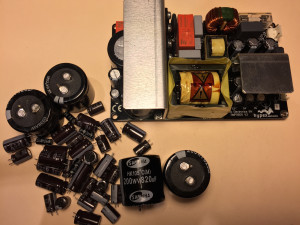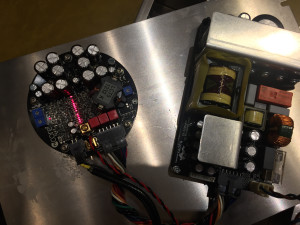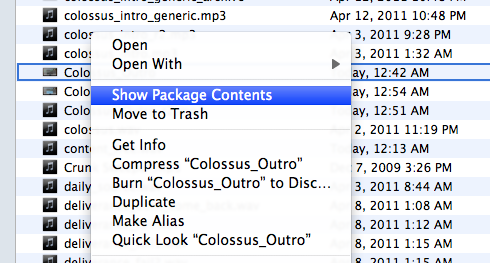A couple of years ago I decided to build myself some class-d amps based on the Hypex NC400 modules. I had also designed some custom billet aluminum cases but I knew they were going to take a while so I put them in temporary enclosures. I had noticed during the summer months when the weather was warmer, one channel would click off. I finally figured out it was thermal shutdown and so I turned the case over and put some metal objects on top to act as heat sinks.
Fast forward to a couple weeks ago, I needed to turn my equipment off to make some changes to the setup. It took me overnight to make all of the changes and when I went to plug the amps in the next day, neither would turn on. No signs of life at all. No clicks, no lights, nothing. I was a little confused that both could die at the same time. They are in separate cases on opposite sides of the room but when I popped them open, I reached for my cap wizard and started testing out some of the caps in the power supply. Turned out several were cooked. Some did not even move the needle on the cap wizard. To my suprise, even one of the largest caps, a 820uf @ 200v, had drifted far out of spec.
I decided I would just replace all of the caps on the power supply boards because I wanted to make sure they were perfectly matched and I figured they all probably have a shortened life span from the heat they incurred. My first task was to remove and map out all of the caps. To get to the 2 largest caps on the board, the large heatsink HS1 needed to be removed. In order to remove that large heat sink, R2 needed to first be removed to access the screw holding D43 to the heat sink. After I got that out of the way, then I could remove and catalog the caps. This board is not particularly easy to work with. The holes are drilled with very small tolerances compared to most. This means you really need to get all of the solder out of the holes or the new components won’t go in easily.
4x 820uf 200v (C1, C15) http://www.digikey.com/product-detail/en/LGW2D821MELB30/493-8519-ND/1966875
16x 220uf 35v (C3, C4, C5, C6, C7, C8, C13, C14) http://www.digikey.com/product-search/en?vendor=0&keywords=35ZLS220MEFC8X11.5
4x 22uf 63v (C22,C26) http://www.digikey.com/product-search/en?KeyWords=63YXJ22M5X11&WT.z_header=search_go
2x 470uf 50v (C9) http://www.digikey.com/product-detail/en/UHW1H471MPD/493-6972-ND/3664388
12x 100uf 100v (C10, C11, C12, C19, C20, C21) http://www.digikey.com/product-detail/en/100YXJ100M10X20/1189-2149-ND/3563802
After that, I ordered the caps for about $40 shipped and replaced them when they showed up. So far so good. Everything seems to be working again. Lesson learned. Even though these amps use a very small amount of power and run very cool for their power outputs, cooling is still super important. I would suggest having plenty of cross-ventilation in your cases. Make sure you leave adequate distance between the amp and power supply. Also make sure your NC400 module is attached to a larger and thicker piece of metal to properly cool it. Apparently a smallish piece of light gauge aluminum is not adequate when in an enclosed space. If you need to replace your caps, ONLY use 105 degree varieties and use the ones rated for the most amount of hours at that temperature.




